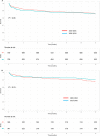Temporal Trends Analysis of the Characteristics, Management, and Outcomes of Women With Acute Coronary Syndrome (ACS): ACS Israeli Survey Registry 2000-2016
- PMID: 31852425
- PMCID: PMC6988167
- DOI: 10.1161/JAHA.119.014721
Temporal Trends Analysis of the Characteristics, Management, and Outcomes of Women With Acute Coronary Syndrome (ACS): ACS Israeli Survey Registry 2000-2016
Abstract
Background Cardiovascular disease remains a leading cause of death among women. Despite improvements in the management of patients with acute coronary syndrome (ACS), women with an ACS remain at higher risk. Methods and Results We performed a time-dependent analysis of the management and outcomes of women admitted with ACS who enrolled in the prospective biennial ACS Israeli Surveys between 2000 and 2016. Surveys were divided into 3 time periods (2000-2004, 2006-2010, and 2013-2016). Outcomes included 30-day major adverse cardiac events (death, myocardial infarction, stroke, unstable angina, stent thrombosis, urgent revascularization) and 1-year mortality. Overall, 3518 women were admitted with an ACS. Their mean age (70±12 years) was similar among the time periods. Over the time course of the study, more women were admitted with non-ST-elevation ACS (51.9%, 59.6%, and 66.1%, respectively; P<0.001), and statins and percutaneous coronary intervention were increasingly utilized (66%, 91%, 93%, and 42%, 60%, and 68%, respectively; P<0.001 for each). Among women with ST-segment-elevation myocardial infarction, more primary percutaneous coronary interventions were performed (48.5%, 84.7%, and 95.3%, respectively; P<0.001). The rate of 30-day major adverse cardiac events has significantly decreased over the years (24.6%, 18.6%, and 13.5%, respectively; P<0.001). However, 1-year mortality rates declined only from 2000 to 2004 (16.9%, 12.8%, and 12.3%; P=0.007 for the overall difference), and this change was not significant after propensity matching or multivariate analysis. Conclusions Over more than a decade, 30-day major adverse cardiac events have decreased among women with ACS. Advances in pharmacological treatments and an early invasive approach may have accounted for this improvement. However, the lack of further reduction in 1-year mortality rates among women suggests that more measures should be provided in this high-risk population.
Keywords: acute coronary syndrome; sex; temporal trends.
Figures




References
-
- Jneid H, Fonarow GC, Cannon CP, Hernandez AF, Palacios IF, Maree AO, Wells Q, Bozkurt B, Labresh KA, Liang L, Hong Y, Newby LK, Fletcher G, Peterson E, Wexler L; Get With the Guidelines Steering Committee and Investigators . Sex differences in medical care and early death after acute myocardial infarction. Circulation. 2008;118:2803–2810. - PubMed
-
- Shaw LJ, Shaw RE, Merz CN, Brindis RG, Klein LW, Nallamothu B, Douglas PS, Krone RJ, McKay CR, Block PC, Hewitt K, Weintraub WS, Peterson ED. Impact of ethnicity and gender differences on angiographic coronary artery disease prevalence and in‐hospital mortality in the American College of Cardiology‐National Cardiovascular Data Registry. Circulation. 2008;117:1787–1801. - PubMed
-
- Kunadian V, Qiu W, Lagerqvist B, Johnston N, Sinclair H, Tan Y, Ludman P, James S, Sarno G; National Institute for Cardiovascular Outcomes Research and Swedish Coronary Angiography and Angioplasty Registries . Gender differences in outcomes and predictors of all‐cause mortality after percutaneous coronary intervention (data from United Kingdom and Sweden). Am J Cardiol. 2017;119:210–216. - PubMed
-
- Yeh RW, Sidney S, Chandra M, Sorel M, Selby JV, Go AS. Population trends in the incidence and outcomes of acute myocardial infarction. N Engl J Med. 2010;362:2155–2165. - PubMed
-
- Rogers WJ, Frederick PD, Stoehr E, Canto JG, Ornato JP, Gibson CM, Pollack CV Jr, Gore JM, Chandra‐Strobos N, Peterson ED, French WJ. Trends in presenting characteristics and hospital mortality among patients with ST elevation and non‐ST elevation myocardial infarction in the National Registry of Myocardial Infarction from 1990 to 2006. Am Heart J. 2008;156:1026–1034. - PubMed
MeSH terms
LinkOut - more resources
Full Text Sources
Medical

